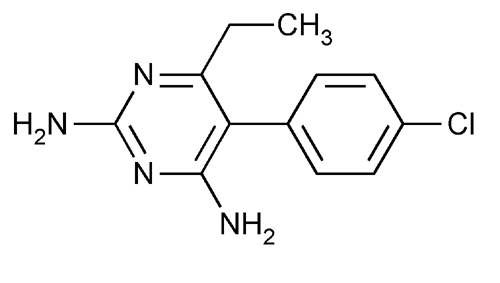Pyrimethamine
2,4-Pyrimidinediamine, 5-(4-chlorophenyl)-6-ethyl-.
2,4-Diamino-5-(p-chlorophenyl)-6-ethylpyrimidine
» Pyrimethamine contains not less than 99.0 percent and not more than 101.0 percent of C12H13ClN4, calculated on the dried basis.
Packaging and storage—
Preserve in tight, light-resistant containers.
Identification—
B:
Mix about 100 mg with 500 mg of anhydrous sodium carbonate, and ignite the mixture. Cool, add 5 mL of hot water, heat for 5 minutes on a steam bath, filter, and neutralize the filtrate with nitric acid: the solution meets the requirements of the test for Chloride  191
191 .
.
C:
The retention time of the major peak in the chromatogram of the Assay preparation corresponds to that in the chromatogram of the Standard preparation, as obtained in the Assay.
Loss on drying  731
731 —
Dry it at 105
—
Dry it at 105 for 4 hours: it loses not more than 0.5% of its weight.
for 4 hours: it loses not more than 0.5% of its weight.
Residue on ignition  281
281 :
not more than 0.1%.
:
not more than 0.1%.
Ordinary impurities  466
466 —
—
Test solution:
a mixture of methanol and chloroform (1:1).
Standard solution:
a mixture of methanol and chloroform (1:1).
Eluant:
a mixture of n-propyl alcohol, glacial acetic acid, and water (8:1:1).
Visualization:
2.
Assay—
0.1% Phosphoric acid solution—
Add 1 mL of phosphoric acid to water, and dilute to 1000 mL.
Mobile phase—
Prepare a suitable degassed and filtered mixture of 0.1% Phosphoric acid solution and acetonitrile (83:17). Make adjustments if necessary (see System Suitability under Chromatography  621
621 ).
).
Standard preparation—
Transfer an accurately weighed quantity of USP Pyrimethamine RS to a suitable volumetric flask, and dilute with 0.1% Phosphoric acid solution to volume to obtain a solution having a known concentration of about 0.02 mg per mL.
Assay preparation—
Transfer an accurately weighed quantity of Pyrimethamine to a suitable volumetric flask, and dilute with 0.1% Phosphoric acid solution to volume to obtain a solution having a known concentration of about 0.02 mg per mL.
Chromatographic system (see Chromatography  621
621 )—
The liquid chromatograph is equipped with a 210-nm detector and a 2.0-mm × 10-cm column that contains 3-µm packing L11. The flow rate is about 0.3 mL per minute. Chromatograph replicate injections of the Standard preparation, and record the peak responses as directed for Procedure: the capacity factor, k ¢, is not less than 2.5; the tailing factor is not more than 1.8; and the relative standard deviation is not more than 1.0%.
)—
The liquid chromatograph is equipped with a 210-nm detector and a 2.0-mm × 10-cm column that contains 3-µm packing L11. The flow rate is about 0.3 mL per minute. Chromatograph replicate injections of the Standard preparation, and record the peak responses as directed for Procedure: the capacity factor, k ¢, is not less than 2.5; the tailing factor is not more than 1.8; and the relative standard deviation is not more than 1.0%.
Procedure—
Separately inject equal volumes (about 5 µL) of the Standard preparation and the Assay preparation into the chromatograph, record the chromatograms, and measure the responses for the major peaks. Calculate the quantity, in percentage, of C12H13ClN4 in the portion of Pyrimethamine taken by the formula:
100(CS / CU)(rU / rS)
in which CS is the concentration, in mg per mL, of USP Pyrimethamine RS in the Standard preparation; CU is the concentration, in mg per mL, of Pyrimethamine in the Assay preparation based on the weighed amount; rU and rS are the peak responses obtained from the Assay preparation and the Standard preparation, respectively; and 100 is the percent conversion factor.
Auxiliary Information—
Please check for your question in the FAQs before contacting USP.
Chromatographic Column—
| Topic/Question | Contact | Expert Committee |
| Monograph | Behnam Davani, Ph.D., M.B.A.
Senior Scientist 1-301-816-8394 |
(MDAA05) Monograph Development-Antivirals and Antimicrobials |
| Reference Standards | Lili Wang, Technical Services Scientist 1-301-816-8129 RSTech@usp.org |
USP32–NF27 Page 3454
Pharmacopeial Forum: Volume No. 33(5) Page 939
Chromatographic columns text is not derived from, and not part of, USP 32 or NF 27.
